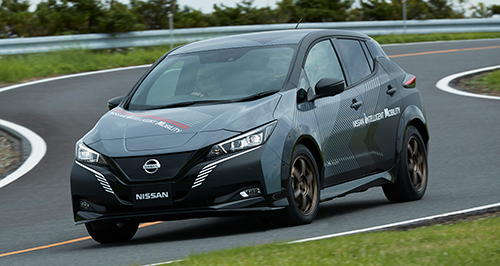Future models - Nissan - LeafNissan previews next Leaf with twin motors, AWDBased on all-electric Ariya, Nissan Leaf mule’s tech hints at massive improvements30 Oct 2019 By BYRON MATHIOUDAKIS in TOKYO NISSAN has unveiled a test mule based on the recently announced Leaf e+ battery-electric vehicle (BEV), which previews a brace of new technologies destined for the next-generation version due in a few years, including twin electric motors availability and all-wheel drive.
Set for the third-generation Leaf due out sometime from 2022, the as-yet-unnamed all-new architecture that will debut first in the closely related Ariya mid-size SUV later next year is what allows for the new technologies, representing the biggest wholesale change to the world’s best-selling BEV since the series debuted in 2010, putting it back at the pointy end of zero-emissions vehicles.
In the Leaf e+ test mule, the combined power output is 227kW and 680Nm, with one EM57 motor located on each axle to provide what Nissan dubs its e-AWD system.
Other details are scant, but GoAuto understands that the suspension – MacPherson struts up front and a multi-link design out back – also offers a level of electronic control.
Aided by controlled motor outputs and regenerative rear-motor braking that works in tandem with the front motor, the result brings what Nissan claims will be “unparalleled ride comfort” due to reduced pitching and diving, head-toss movement and motion sickness.
Furthermore, along with front and rear torque allocation, the system applies independent brake control to each wheel, boosting cornering forces generated by each tyre for smoother and more secure steering, handling and roadholding – something the existing Leaf is not renowned for.
“Soon, Nissan will launch a next-generation EV (2021 model-year production Ariya) that will be a true breakthrough,” said Nissan Motor Company vice-president for research and advanced engineering Takao Asami.
“The new electric-drive four-wheel-control technology now being developed integrates Nissan’s electric propulsion and 4WD control technologies with our chassis control technology to achieve a huge leap in acceleration, cornering and braking performance, on par with the latest sportscars.”
Nissan global design chief Alfonso Albaisa added that the new architecture will also allow for a substantially roomier and more versatile cabin compared to the current Leaf, as it and the original were packaged like a regular internal-combustion engine (ICE) C-segment hatch so as not to scare off more conservative buyers.
“The first Leaf was designed nearly 15 years ago,” he explained, “and there was no EVs anywhere and no charging stations essentially anywhere in the world, so that car needed to be an icon separate from the portfolio, but the decision with the second Leaf was to go more into the current portfolio, because now EVs are normal, so it merged in.
“But please understand, there will be a much bigger difference between the (current) Leaf and the next generation of EVs. (Today’s) Leaf uses many components from an ICE car, because the focus of the Leaf is electrification for everyone – it’s not a super-expensive car. So, now, the next generation of cars are completely designed from zero as an EV.
“We are very proud of the first two generations of Leaf, (since) we’ve sold nearly half a million cars globally and 12 billion kilometres driven, and because of that (experience), we can now make Ariya.”  Read moreAll motor show Alfa Romeo Alfa Romeo Abarth Abarth Alpine Alpine Alpina Alpina Audi Audi Aston Martin Aston Martin BMW BMW Bentley Bentley Chery Chery Brabham Brabham Chrysler Chrysler Chevrolet Chevrolet Cupra Cupra Citroen Citroen DS DS Dodge Dodge Fiat Fiat Ferrari Ferrari Foton Foton Ford Ford Great Wall Great Wall FPV FPV Haval Haval GWM GWM Honda Honda Holden Holden Hummer Hummer HSV HSV Infiniti Infiniti Hyundai Hyundai Jaguar Jaguar Isuzu Isuzu Kia Kia Jeep Jeep Land Rover Land Rover Lamborghini Lamborghini Lexus Lexus LDV LDV Mahindra Mahindra Lotus Lotus Mazda Mazda Maserati Maserati Mercedes-AMG Mercedes-AMG McLaren McLaren MG MG Mercedes-Benz Mercedes-Benz Mitsubishi Mitsubishi Mini Mini Opel Opel Nissan Nissan Peugeot Peugeot Pagani Pagani Proton Proton Porsche Porsche Renault Renault Ram Ram Rover Rover Rolls-Royce Rolls-Royce Skoda Skoda Saab Saab SsangYong SsangYong Smart Smart Suzuki Suzuki Subaru Subaru Toyota Toyota Tesla Tesla Volvo VolvoMotor industry news |
Click to shareAll motor show Alfa Romeo Alfa Romeo Abarth Abarth Alpine Alpine Alpina Alpina Audi Audi Aston Martin Aston Martin BMW BMW Bentley Bentley Chery Chery Brabham Brabham Chrysler Chrysler Chevrolet Chevrolet Cupra Cupra Citroen Citroen DS DS Dodge Dodge Fiat Fiat Ferrari Ferrari Foton Foton Ford Ford Great Wall Great Wall FPV FPV Haval Haval GWM GWM Honda Honda Holden Holden Hummer Hummer HSV HSV Infiniti Infiniti Hyundai Hyundai Jaguar Jaguar Isuzu Isuzu Kia Kia Jeep Jeep Land Rover Land Rover Lamborghini Lamborghini Lexus Lexus LDV LDV Mahindra Mahindra Lotus Lotus Mazda Mazda Maserati Maserati Mercedes-AMG Mercedes-AMG McLaren McLaren MG MG Mercedes-Benz Mercedes-Benz Mitsubishi Mitsubishi Mini Mini Opel Opel Nissan Nissan Peugeot Peugeot Pagani Pagani Proton Proton Porsche Porsche Renault Renault Ram Ram Rover Rover Rolls-Royce Rolls-Royce Skoda Skoda Saab Saab SsangYong SsangYong Smart Smart Suzuki Suzuki Subaru Subaru Toyota Toyota Tesla Tesla Volvo VolvoMotor industry news |
















Facebook Twitter Instagram